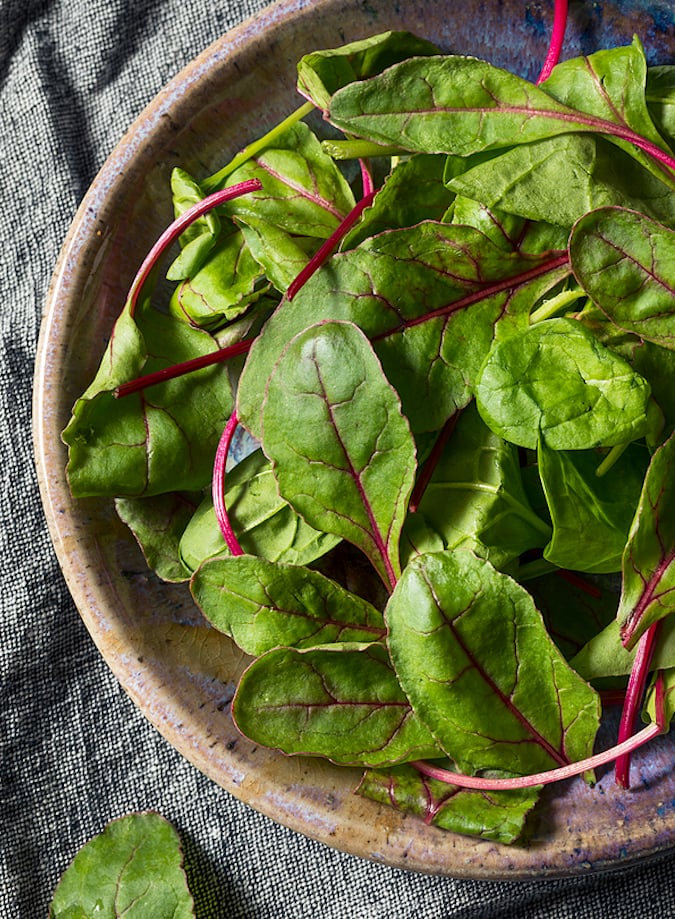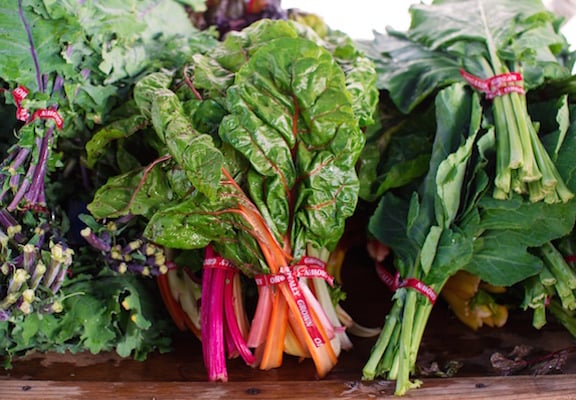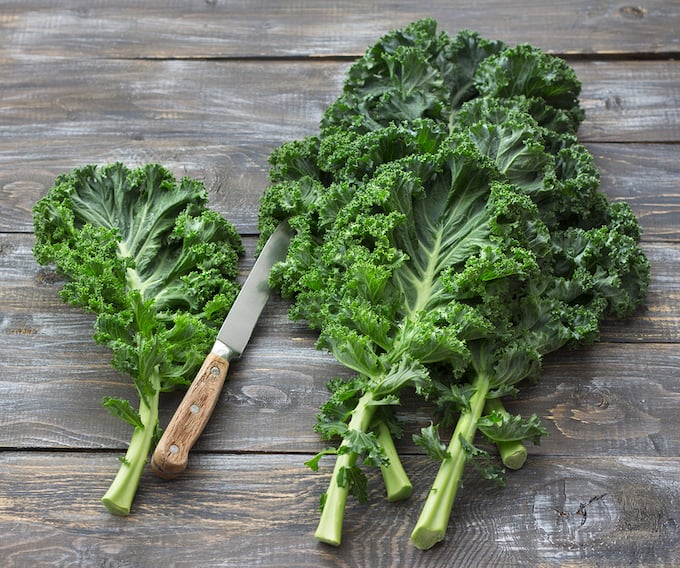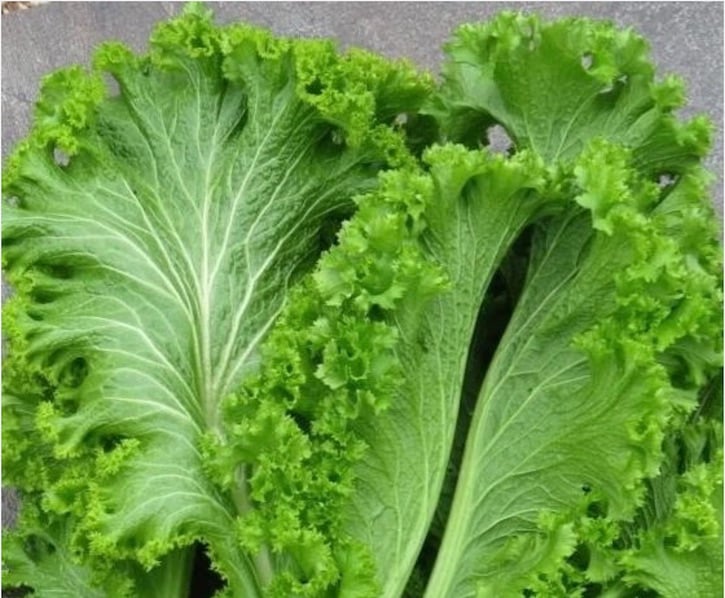Most of us have eaten spinach and many have gotten familiar with kale. But there are lots of other common leafy green vegetables we can be using more often. This green leafy vegetables list will help you make them a great addition your daily fare.

Dark leafy green vegetables are one of the cornerstones of a well-rounded plant-based diet. They’re the most nutrient-rich vegetable group on the planet, and are so versatile in the kitchen. Here are 10 leafy greens that deserve a place in your daily fare.
Following each entry are a few links to recipes for using the greens listed. We’re not going to get into salad greens like romaine lettuce here, but rather stay focused on the dark leafy veggies.
Why greens are good for you
We know by now that leafy greens are among the most nutrient-dense foods of common vegetables. Leafy greens are sources of Vitamin K, essential to bone health, and are abundant in vitamins A, B (especially folic acid) and C. Greens also provide a wealth of antioxidants and chlorophyll, are protective against cancers, and are anti-inflammatory.
The hardier greens, like kale, chard, and collards, are superb sources of highly absorbable calcium, a perk that’s especially valuable to vegans.
When it comes to nutritional value, leafy greens often top lists of nutritional powerhouses, for good reason. These green wonders offer numerous benefits, including these:
- Leafy greens are good sources of vitamins, notably folic acid (one of the B vitamins), vitamin A, and vitamin C. They’re a particularly notable source of vitamin K, which is essential to good bone health.
- They’re also a rich source of minerals, including potassium, magnesium, and iron.
- The calcium content in some leafy greens, especially kale, collard greens, and spinach, is significant. The calcium is also highly absorbable, unlike that in other foods. Thus, for vegans and those who don’t consume dairy calcium for other reasons, dark leafy greens can become an important and reliable source for this mineral.
- Greens contain large amounts of phytochemicals with antioxidant properties. Carotenoids play a role in protecting the eyes; they and flavonoids like quercetin have been shown to protect against certain cancers.
- Other benefits common to many greens is that they’re anti-inflammatory, they can help control blood pressure, and help detoxify the body and regulate blood sugar.
- Any number of greens, notably kale, collards, spinach, chard, and mustard greens are a modest but reliable source of valuable Omega-3 fatty acids.
- Greens have a high fiber content, which makes them great for the digestive tract and for weight maintenance. They’re also quite low calorie and low in carbohydrates.
- Dark leafy green vegetables are a great source of chlorophyll. This is the pigment that makes leaves green and has all manner of health benefits, including overall support for all our internal systems. Many claims are made for the ability of chlorophyll to reverse or allay the effects of aging. Chlorophyll is most available in raw greens, which is why their concentration in green smoothies and green juices is so valuable—especially the latter.
Here’s more on the healthiest leafy green vegetables and why you need to eat your greens.
Related Posts
For more in-depth information on greens, and a wealth of easy, tasty recipes, see Wild About Greens by Nava Atlas.

ARUGULA
Arugula is a cool-weather green, making an early spring appearance with a follow-up in the fall, when it grows late into the season. It’s sometimes known by its European name of “rocket” or “rocket salad.”
Arugula’s flavor is often described as peppery or mustardy, though somehow that doesn’t accurately capture its unique flavor. Baby or young arugula leaves are less pungent than larger leaves that are left to grow larger before harvesting. Arugula is best used raw, to its pleasant bite, or lightly wilted.
Arugula can often be used interchangeably with spinach in many dishes, or it can replace part of the amount of spinach called for. It’s quite versatile, and can be used in green salads (it mixes well with tender lettuces like Boston or Bibb); in sandwiches in place of lettuce; wilted over pizza hot out of the oven; wilted into pasta and grain dishes, and they’re a great way make pesto.
See more in our Guide to Arugula.
Recipes
- Roasted Butternut Squash Salad with Arugula & Pumpkin Seeds
- Tri-Color Potato & Arugula Salad
- Spinach or Arugula Scrambled Tofu

BEET GREENS
These are, not surprisingly, the greens attached to the beet root, and chances are, if you come across them, you’ll usually be getting the beets as well as the greens, but lately, you can also get baby beet greens on their own, as pictured above.
Beet greens are comparable to Swiss chard, not only in appearance, but in their earthy taste, with a slightly salty undertone.
You can use beet greens raw, but they’re a bit more pleasing when lightly steamed or wilted. If you ever do find yourself with an abundance of beet greens, use them in place of or in addition to chard or spinach in cooked dishes. For juices or smoothies that use beets, the greens are a wonderful addition.
Other greens that come attached to their root vegetables: These include turnip greens and radish greens; they can be used in the same ways suggested here for beet greens if they look firm and fresh.
Recipes

BOK CHOY
Bok choy is likely he most widely known and available of Asian greens. There are two varieties you’ll likely come across — the large kind with crisp white stalks and dark leaves; and baby bok choy. The latter is a smaller version, with stems and leaves that are all a pale green.
Most people who have eaten in Chinese restaurants have likely eaten this mild, easy-to-like vegetable. Bok hoy is a kind of two-for-the-price-of-one item: A crisp veggie and leafy greens in one neat package. Though you wouldn’t think to look at it, bok choy is a good plant-based source of calcium.
Either of the common varieties of bok choy is equally good raw in salads or very lightly cooked in stir-fries and Asian-style soups. To prepare, they’re usually just stemmed (an inch or so needs to be trimmed off the bottom of the larger bok choy stalks) and sliced, leaves and all.
See more in our Guide to Bok Choy.
Recipes
- Ginger & Garlic Stir-Fried Bok Choy
- Baby Bok Choy Salad with Apple & Carrot
- Hoisin-Ginger Udon Noodles with Bok Choy

CHARD
This abundant home garden vegetable, a relative of both beets and spinach, is often generically (and not always accurately) referred to as Swiss chard. There are several varieties of this useful leafy green, and they’re completely interchangeable.
Some common types other than Swiss are green, red, gold, and silverbeet. Rainbow chard is a 5-color silverbeet, which grows with a variety of stem colors. These are packaged together to create the rainbow of colors.
Of all the larger-leafed greens, chard’s stems the most palatable. And because they’re also often colorful, they add visual interest to a dish — their flavor and texture are somewhat like a softer, milder version of celery.
Though chard stands out as the star of simple preparations, it more than holds its own with bold-flavored grain, bean, and potato dishes as well as in soups and stews. While it isn’t unheard of to eat chard raw, the ever-so-slightly bitter taste/salty flavor and chewy texture of the leaves are more appealing when lightly cooked.
See more in our Guide to Chard.
Recipes
- Pasta with Chard & White Beans
- Curried Sweet Potatoes with Chard & Chickpeas
- Brussels Sprouts with Chard

COLLARD GREENS
Best known from the cuisine of the American South, collards greens, with their large, dark green leaves, were the biggest surprise for me when I was expanding my repertoire. I had most often seen recipes that called for boiling the leaves for 20 minutes or more, or braising them for an equally long time. When I tried these techniques, I just found the semi-mushy, olive-drab results less than exciting.
But quick-braised, stir-fried, sautéed with a little garlic and olive oil, or even roasted, collard greens are a standout, and their mild, sweet flavor appeals to most palates.
Collard greens belong to the family of cruciferous vegetables (which includes cabbage and broccoli). The newest, coolest way to cook collard greens (though not the only way, of course) is to roll up the leaves, slice them very thinly, and stir-fry until just tender-crisp, retaining their wonderful color and sweetness.
Because of their mild flavor, collard greens are fantastic used raw (in small quantities) in green They’re especially good in stews, teamed with other cruciferous vegetables like green or napa cabbage, and in dishes featuring grains and beans.
See more in our Guide to Collard Greens.
Recipes
- Roasted Collard Greens with Brussels Sprouts & Polenta
- Stir-Fried Collard Greens & Cabbage & Carrots
- Vegan Southern Collard Greens

ESCAROLE
Escarole looks like a slightly denser, greener version of romaine lettuce, and is a much-loved vegetable in Italian cuisine. Despite its lettuce-like appearance, escarole benefits from brief cooking to temper its mildly bitter bite. It’s a member of the chicory family, a relative of curly endive and radicchio.
If you enjoy a green that’s a bit of a challenge to the tooth and slightly bitter in salads, you can shred escarole thinly and add a small quantity to salads featuring milder greens.
However, you may find, as I do, that escarole is more palatable with judicious cooking. It wilts down quickly in sautés, and becomes downright comforting in soups like the classic potato and escarole soup.
See more in our Guide to the Chicory Vegetables.
Recipes

KALE
Some years ago, kale inspired such devotion that it inspired sweatshirts and T-shirts reading “Kale University.” It’s almost right up there with spinach in terms of versatility. It’s a leafy green that’s as welcome in warming stews as in a refreshing green smoothie. And though kale-mania seems to have leveled off, it’s still a veggie much deserving of a regular place on the plate.
Like its cousin, collard greens, Kale is a cruciferous vegetable, the family of veggies that broccoli and cauliflower belong to.
Kale comes in several varieties, the most commonly available of which are: curly; lacinato (also called dinosaur kale); and Russian. Lacinato kale has long, narrow leaves that are a handsome forest green (see top image in this post), sometimes even blue-green.
Russian kale is also curly, with red-tipped leaves with a slightly less sweet flavor than its monochromatic counterparts. This variety works best lightly cooked; curly and laminate are good both raw and cooked.
To use kale raw, make sure to massage the leaves first to make them more tender and palatable. See more information in How to Massage Kale. And we still love our oven-baked kale chips!
See our full roundup of tasty, easy kale recipes, which include:
Recipes
 Photo: SowTrueSeeds.com
Photo: SowTrueSeeds.com
MUSTARD GREENS
I didn’t have much to do with mustard greens before starting to research my book, Wild About Greens. First of all, it often comes in huge bunches. But I’m happy to say that I’ve become a fan.
The flavor of mustard greens has been described as pungent or peppery, though I’d characterize it as sharp, like horseradish. Like many greens that have a certain bite to them, these bold greens mellow quite a bit when lightly cooked.
Another nice thing about mustard greens is that they need not be stemmed. After trimming away the bottom of a head of mustard greens, the remaining leaf and stem can be chopped together.
Recipes

SPINACH
Though spinach is considered a cool-weather garden green, it’s available all year round. Because of its mild flavor, it’s quite possibly the most versatile of all the leafy greens. It’s certainly the most widely-known and well-traveled as a staple in many global cuisines.
Spinach comes in a surprising array of varieties, with leaf types ranging from flat to semi-savoyed (a.k.a. “crinkled”). Leaf sizes vary from baby spinach to the large, almost chard-like Malabar or summer spinach. The latter is best lightly cooked, while the other varieties are equally good used raw or very lightly cooked. “Lightly” is the operative word here.
What’s most commonly available these days is baby spinach, which comes in plastic packages of about 5 ounces. These are labeled “triple-washed,” so you need not wash or stem them. I do still give them a good rinse before using though, because you just can’t be too careful.
What’s nice about baby spinach is that biting into sandy leaves is no longer an issue; but it’s sad not to have access to more unusual varieties, unless you shop at a farmers’ market or belong to a CSA.
Whether completely blended into a refreshing juice or smoothie, at the heart of a salad, or wilted into any number of warm dishes, it’s hard to beat this nutritious superstar for versatility.
Recipes
- Classic Summer Spinach & Berries Salad
- Lemony Spinach Rice with Fresh Herbs
- Avocado, Spinach, & Tahini Dip

WATERCRESS
To describe the flavor watercress as peppery is a culinary cliché, but there’s no other word for it. A member of the mustard family, the peppery heat comes from the mustard oils that are released when the leaves are chewed. It’s often cited as one of the most nutrient-dense of the leafy greens.
Watercress has a mild and pleasant bit, and as a tender, vitamin-C rich green, it’s easy to love. You have to use your eagle eye though, as its bouquet-like bunches are small and can get lost in the offerings of the average produce section.
Watercress has small, round leaves topping long, slender stems. The stems are edible and you can use as much or as little of them as you choose; it’s a purely aesthetic decision.
It’s used to its best advantage raw in salads and is also good in sandwiches in place of lettuce. Watercress is also good as a last-minute addition to soups and very briefly wilted in stir-fries.
See more in our Guide to Watercress.
Recipes
- Watercress Salad with Oranges & Cucumber
- Smoky Watercress & Chickpea Salad with Mango & Avocado
- Watercress Soup with Potatoes & Peas
Asian Greens: Try adding some Asian greens like tatsoi and mizuna to your green leafy vegetables list. These can be swapped in for baby spinach or arugula. And you may also like A Guide to Gai Lan (Chinese Broccoli).
See more of our Good Food Guides.


Leave a Reply